
In its latest physician salary report, Medscape surveyed 13,000 physicians in 29 specialties to detail how physician compensation changed in 2021. The new survey revealed that physician income is back on the rise, after stagnating in 2020 due to impacts from the COVID-19 pandemic.
A look at the headline figures from the past three years illustrates the trend. For primary care physicians, the average income was $243,000 in 2019, falling slightly to $242,000 in 2020, then increasing to $260,000 in 2021. Specialists reached an average compensation of $368,000 in 2021, up from $344,000 in 2020, which was a bit down from $346,000 in 2019.
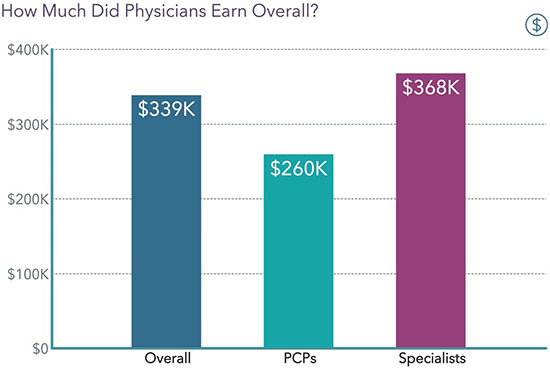
While this is good news overall, Medscape points out that recent increases are just a beginning for physicians who are still recovering from the salary stagnation of 2020.
Starting salaries for physicians
This particular Medscape report does not report on starting salaries. However, it’s worth noting a few 2022 statistics.
Physician starting salary
An entry-level physician’s salary varies greatly depending on education, certifications, additional skillset, and geographic region. Salary.com reports the average starting salary for a physician in the United States is $208,632, but falls between $180,640 and $233,367.
Starting salary for physician assistants
As for physician assistants, the average entry-level salary also varies widely in the United States. Salary.com reports an average starting salary for physician assistants as $104,431, with a salary range typically falling between $97,076 and $112,149. However, ZipRecruiter reports a much lower average starting salary of $79,423.
How much do doctors make by specialty?
Virtually all physician specialties saw an income increase in 2021, which Medscape notes is a first since it began tracking physician compensation. Otolaryngology saw the largest increase, at 13%, while critical care physicians — who in many cases faced the brunt of the pandemic in hospitals — logged an increase of just 1%.
The list of highest-paid specialties has remained virtually unchanged since 2017. The top-earning specialty was plastic surgery at $576,000. The next four, in descending order, are orthopedics, cardiology, otolaryngology, and urology.
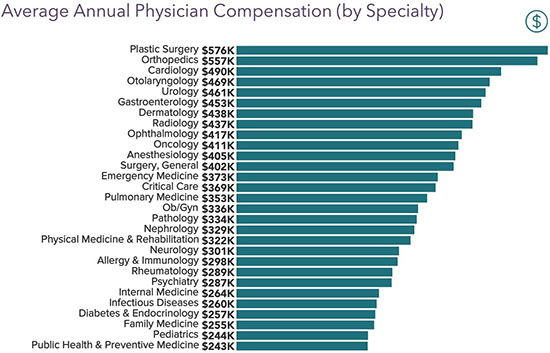
Average plastic surgeon salary: $576,000
Physicians’ attitudes about their compensation vary widely among the specialties. The top five specialties in which physicians said they felt fairly compensated include public health and preventive medicine, oncology, plastic surgery, psychiatry, and dermatology. On the other hand, nephrology physicians felt the most unfairly compensated, followed by diabetes and endocrinology, pediatrics, physical medicine and rehabilitation, internal medicine and OB/GYN physicians. In each of those specialties, fewer than 50% of respondents said they felt fairly compensated.
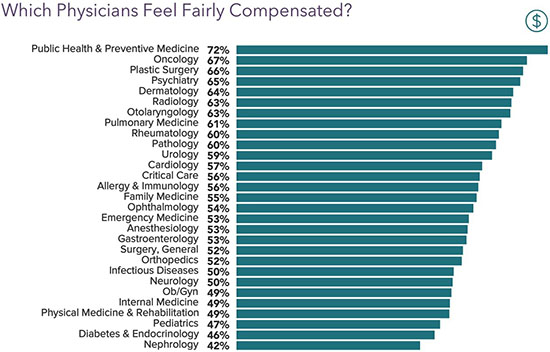
Administrative burdens leading to doctor burnout
Salary alone is not dictating a physician’s career path. Work conditions and culture also play a role. One grievance leading to physician burnout is the day-to-day administrative tasks that eat into time spent with patients.
On average, physicians reported spending 15.48 hours per week on administration and paperwork. This type of work contributes to stress and overwork physicians, and it can cut into billable patient-facing hours. According to the Medscape report, the most paperwork-intensive specialties were infectious diseases (19.8 hours per week), internal medicine (18.7), neurology (17.7), nephrology (17.7), and physical medicine and rehabilitation (17.4).
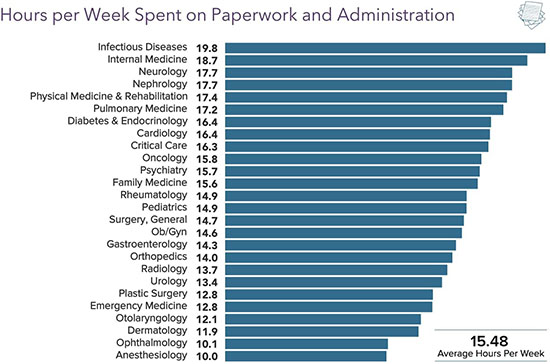
The least administrative/paperwork-intensive specialties were anesthesiology (10), ophthalmology (10.1), dermatology (11.9), otolaryngology (12.1), emergency medicine (12.8), and plastic surgery (12.8). Of note, some of the highest-paying specialties (otolaryngology, plastic surgery) faced among the lowest administrative and paperwork burdens.
How much do locum tenens make?
Another point of difference is between self-employed and employed physicians. At an average of $385,000, self-employed physicians, which includes locum tenens physicians, earned 20% more than employed physicians, who earned $320,000 on average.
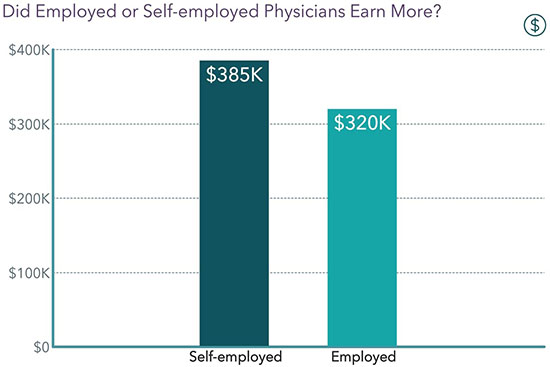
More than a third of physicians (36%) took on extra work to supplement their income. Some of the sources of this supplemental work include adding hours to their primary work and taking medical or non-medical side jobs. A full 10% of physicians reported medical moonlighting, which would include locum tenens side work.
Is there a gender pay gap in medicine?
The short answer is yes. The gender pay gap between male physicians and female physicians has not improved over the past decade. In fact, the trend shows a slight worsening: in 2012, the gap in primary care between men and women was 23%, while the latest report puts it at 25%. According to the Medscape survey, male primary care physicians earned an average of $285,000 in 2021, while women earned $228,000.
On the other hand, the gender pay gap among specialists has declined — although it’s still greater than the pay gap between male and female primary care physicians. The gap among specialists sits at 31%, which is down from 37% five years ago. Male specialists earned an average of $402,000 in 2021; female specialists earned $307,000.
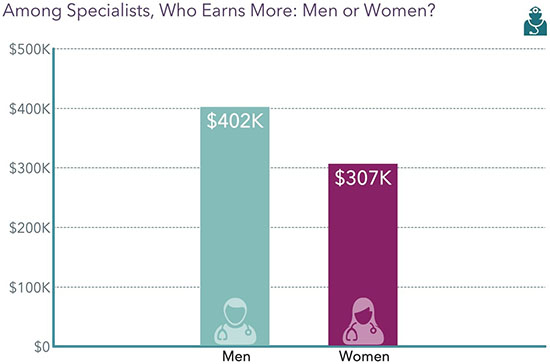
Women see their highest representation in pediatrics (58%) and OB/GYN (57%). The only other specialty where they make up more than 50% of physicians is diabetes/endocrinology (52%).
Women face their lowest representation in urology (8%), orthopedics (11%), plastic surgery (16%), and cardiology (16%). Of note, three of these specialties — orthopedics, plastic surgery, and cardiology — are among the top five highest compensated specialties.
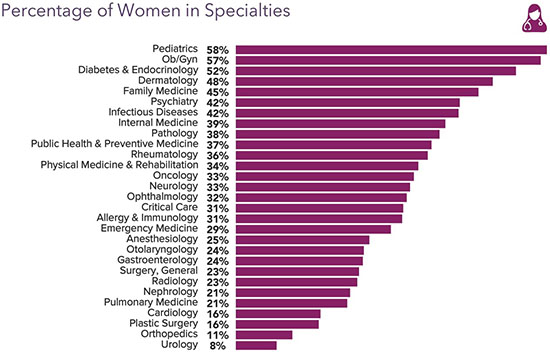
Geographic differences in physician salary
The average physician salary can vary notably from state to state. In 2021, Kentucky came out on top among the highest-paying states for physicians with an average physician salary of $364,000. Other states in the top 10 for compensation include (in descending order): Tennessee, Alabama, Missouri, Oregon, Indiana, North Carolina, Connecticut, Texas, and Florida. According to Medscape, southern states have made extra efforts to attract physicians, including increasing salaries and offering sign-on bonuses.
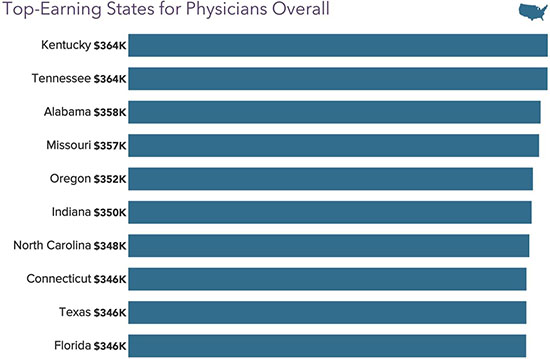
While many physicians are still recovering from the effects of the COVID-19 pandemic, physician earnings have generally rebounded. Overall, Medscape’s 2022 physician salary report suggests that physician compensation will continue to grow.
Physician assistant salary by state
While we’re on the topic of physician salaries, it’s worth mentioning physician assistant salaries as well. In 2022, a recent physician assistant salary by state reports that PAs are experiencing salary growth after pandemic setbacks.
Physician salary by specialty
As noted previously, there are many variables when it comes to a physician’s salary: geographic location, administrative burden, gender, and employed versus self-employed (locum tenens). Salary by specialty also varies tremendously.
Want to dive deep into salary by specialty? Weatherby provides the most recent reports below:
Internal Medicine Physician Salary
Critical Care Physician Salary
Locum tenens is great way to supplement your physician income. To learn more call 954.343.3050 or view locum tenens job opportunities.
Chart images from Medscape.com
Article last updated November 9, 2022


